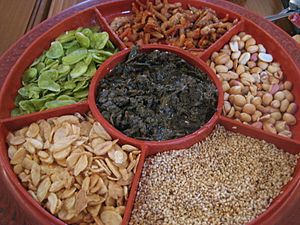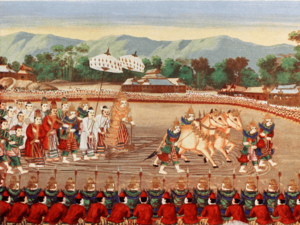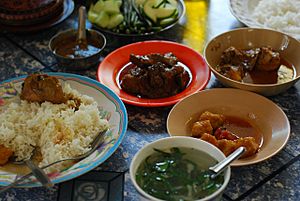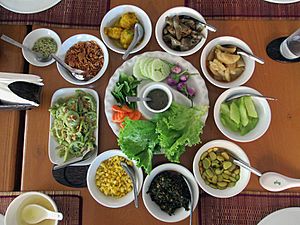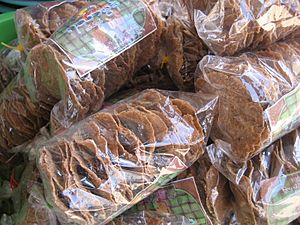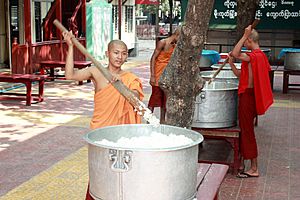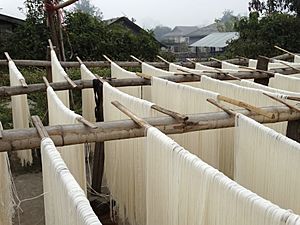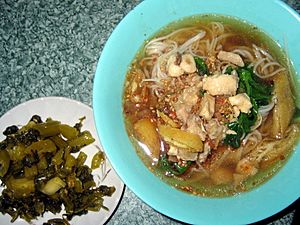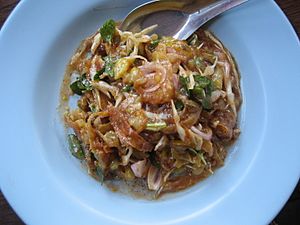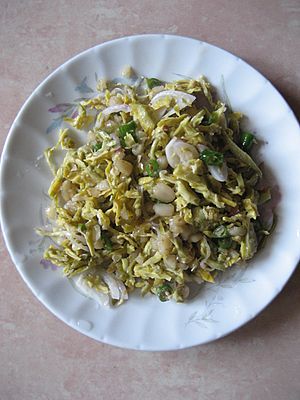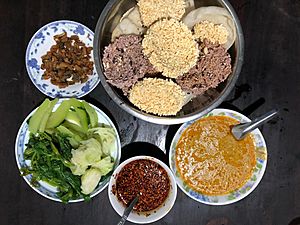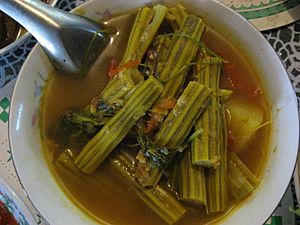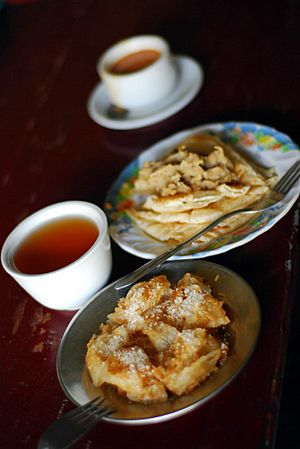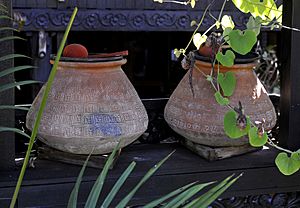Burmese cuisine facts for kids
Burmese cuisine (Burmese: မြန်မာ့အစားအစာ) is all about the many different food traditions found in Myanmar. These traditions have grown over thousands of years thanks to farming, changes in society and economy, and trading with nearby countries like India, China, and Thailand. Myanmar is located where South Asia, Southeast Asia, and East Asia meet, which has brought many exciting flavors and cooking styles together.
Burmese food includes a wide variety of dishes. You'll find traditional curries, fresh Burmese salads, and tasty soups. These are usually eaten with white rice. Noodles are also very popular, served in many ways: fried, in soups, or as noodle salads. You'll also see Indian breads. Plus, there's a lively street food scene with lots of traditional Burmese fritters and snacks called mont.
The main flavors in Burmese cooking are often described as chin ngan sat, which means "sour, salty, and spicy." A fun Burmese saying captures some favorite foods: "Of all the fruit, the mango's the best; of all the meat, the pork's the best; and of all the leaves, lahpet's the best."
Contents
History of Burmese Food
Rice is the most important food in Burmese cuisine. People have been growing rice in Myanmar for thousands of years, especially in the Chindwin, Ayeyarwady, and Thanlwin river valleys. By 3000 BCE, farmers were already using irrigation to grow rice, and they also raised cattle and pigs.
Tea also started in the areas between Myanmar and China. This led to a long tradition of drinking tea and making laphet, which is pickled tea. Laphet is still very important in Burmese traditions today. The Burmese word for "tea" is unique and doesn't come from the Chinese word, showing how long tea has been part of their culture.
Over time, different kingdoms and states formed in Myanmar, including the Bamar, Mon, Shan, and Rakhine people. Growing rice is still a big part of life for these groups who live in the fertile lowlands.
Burmese food has also been greatly influenced by trade and contact with other countries. In the 15th and 16th centuries, new foods like tomatoes, chili peppers, peanuts, and potatoes arrived. Wars with Thailand between the 16th and 19th centuries also brought Thai-inspired treats like khanon dok, shwe yin aye, mont let hsaung, and Yodaya mont di.

Food has always been closely linked to religious life, especially for Buddhists. They often give food as alms (dāna) and have big community meals called satuditha and ahlu pwe. One of the oldest cookbooks, the Sadawhset Kyan, was written in 1866 on a palm leaf. During the Konbaung dynasty (16th to 19th centuries), special food preparations were a big part of royal ceremonies, used as offerings and for celebrations.
When the British were in charge of Burma (19th and 20th centuries), many Indian and Chinese communities settled there. They brought new cooking methods, ingredients, and dishes that are now a key part of Burmese cuisine. This includes Indian breads like naan and paratha, and Chinese cooking styles like stir frying with ingredients like tofu and soy sauce.
Dining Customs and Etiquette
How Burmese People Eat
Traditionally, Burmese people eat meals from plates placed on a low table called a daunglan, while sitting on a bamboo mat. All the dishes are served at once and shared by everyone. A typical meal includes steamed white rice, curries, a light soup, and side dishes like fried vegetables, Burmese fritters, and ngapi yay gyo. This last dish is a dip made from pickled fish, served with fresh and blanched vegetables. Meals often end with a piece of palm sugar or laphet (fermented tea leaves).
To show respect, the oldest people at the table are always served first. Even if elders aren't there, the first bit of rice from the pot is set aside as a sign of respect to parents. This custom is called u cha.
Burmese people traditionally eat with their right hand. They form a small ball of rice with their fingertips, mix it with other foods, and then put it in their mouths. For noodle dishes, chopsticks and Chinese-style spoons are used, though noodle salads are often eaten with just a spoon. Forks and knives are also becoming more common now.
Food and Religion
Myanmar has many different religions, which affect its food. Buddhists and Hindus usually avoid beef, while Muslims avoid pork. Many devout Buddhists and farmers consider beef taboo because cows are important working animals.
Vegetarianism is common for Buddhists during the three-month Vassa (from July to October) and on special holy days. The Burmese word for "vegetarian" is thet that lut, meaning "free of killing." During Vassa, many devout Buddhists follow special rules, including eating only two meals a day, before noon.
Why Some Avoid Beef
The custom of avoiding beef is quite common in Myanmar, especially among Buddhists. In Myanmar, beef usually comes from cattle that are old or sick, not from animals raised just for meat. Most cattle in the country are used for farm work. Few people eat beef, especially among the Bamar and Burmese Chinese, though it's more common in the food of ethnic groups like the Kachin. When Buddhists give up meat, beef is often the first thing they stop eating. Many butchers are Muslim because of the Buddhist idea of ahimsa (not harming living things).
In the past, during the Konbaung dynasty, eating beef regularly could even be punished. A famous Buddhist monk, Ledi Sayadaw, wrote a letter in 1885 explaining why Buddhists shouldn't kill cattle or eat beef. He said farmers depended on them and that eating beef could lead to cattle disappearing. He led successful boycotts against beef during the time the British were in charge.
Cooking Styles
Burmese dishes don't usually follow exact recipes. The amount of ingredients might change, but getting the timing right is very important. Burmese food can be stewed, boiled, fried, roasted, steamed, baked, or grilled, or a mix of these methods. Burmese curries use fewer spices than Indian ones, but they use more fresh garlic and ginger.
Regional Food Styles

Burmese cuisine can be broadly divided into two main styles: food from Upper Myanmar, which is inland, and food from Lower Myanmar, which has many rivers and is near the Andaman Sea. The differences come from what fresh ingredients are available. Myanmar's long coastline means lots of fresh seafood, which is a big part of Rakhine food. There's a Burmese saying that goes: "Mandalay for eloquence, Yangon for boasting, Mawlamyaing for food," showing how famous Mawlamyaing is for its cuisine.
Food in Lower Myanmar, including Yangon and Mawlamyaing, uses a lot of fish and seafood products like fish sauce and ngapi (fermented seafood). In Upper Myanmar, including the Bamar heartland (Mandalay, Magway, and Sagaing Regions), Shan State, and Kachin States, people tend to use more meat, poultry, beans, and pulses. The amount of spices and fresh herbs varies; Kachin and Shan curries often use more fresh herbs.
Fusion Chettiar cuisine, which mixes Southern Indian flavors, is also popular in cities.
Dishes and Ingredients
Since there isn't one standard way to write Burmese words using English letters, the pronunciations below are close to how they sound.
Preserved Foods
Myanmar is one of the few countries where tea is not just for drinking, but also for eating! This is lahpet, which is pickled tea served with different toppings. Eating tea dates back a very long time in Myanmar, from tribes who pickled tea leaves in bamboo or plantain leaves. Tea leaves are traditionally grown by the Palaung people. Pickled tea leaves are still very important in Burmese culture today.
Ngapi (ငါးပိ), a fermented paste made from salted fish or shrimp, is a key ingredient in almost every traditional Burmese meal. It's used to flavor many soups, salads, curries, and sauces, giving them a rich umami (savory) flavor. Ngapi from Rakhine State has little or no salt and uses sea fish. Ngapi made with freshwater fish is common in other regions. Ngapi yay (ငါးပိရည်) is a vital part of Karen and Bamar food. It's a sauce made from ngapi cooked with vegetables and spices, served with blanched and fresh vegetables for dipping.
Shan cuisine often uses fermented beans called pè ngapi (ပဲငါးပိ; meaning "bean ngapi") instead of fish ngapi to add a savory taste. Dried bean ngapi chips (ပဲပုပ်; meaning "spoiled beans") are used as toppings for many Shan dishes.
Pon ye gyi (ပုံးရည်ကြီး), a thick, salty black paste made from fermented beans, is popular in the Bamar heartland. It's used in cooking, especially with pork, and as a salad with peanut oil, onions, and chili. Bagan is famous for making pon ye gyi.
Burmese cuisine also has many pickled vegetables and fruits. Some are preserved in oil and spices, like mango pickle. Others are preserved in brine and rice wine, like mohnyin gyin.
Rice Dishes
The most common main food in Myanmar is steamed rice, called htamin (ထမင်း). Fragrant kinds of white rice, like paw hsan hmwe, are very popular. Sticky rice, called kauk hnyin, is also used, including a purple kind called ngacheik. People in the northern mountains prefer stickier rice, while those in the lower delta regions like less sticky kinds. Sticky rice is often used in traditional Burmese snacks called mont. While rice is usually eaten plain, flavored versions like buttered rice and coconut rice are popular for celebrations.
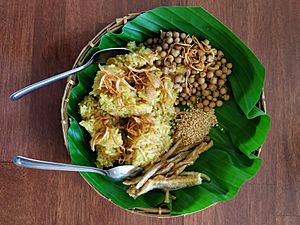
- Htamin gyaw (ထမင်းကြော် [tʰəmɪ́ɴ dʒɔ̀]) – Fried rice with boiled peas, sometimes with meat, sausage, and eggs.
- San byok (ဆန်ပြုတ် [sʰàɴbjoʊʔ]) – Rice porridge with fish, chicken, or duck, often given to people who are sick.
- Danbauk (ဒံပေါက် [dàɴbaʊʔ]) – Burmese-style biryani with chicken or mutton, served with mango pickle, a fresh salad, fried dried chilies, and soup.
- Htamin jin (ထမင်းချဉ် [tʰəmíɴ dʒɪ̀ɴ]) – A rice, tomato, and potato or fish salad, shaped into balls and topped with fried onion, tamarind sauce, and other garnishes.
- Thingyan rice (သင်္ကြန်ထမင်း [ðədʒàɴ tʰəmɪ́ɴ]) – Rice boiled in candle-scented water, served with pickled marian plums.
Noodle Dishes
Burmese cuisine uses many different kinds of noodles. They are served in soups, salads, or as dry dishes, often eaten as a snack or outside of lunch. Thin rice noodles called mont bat or mont di are similar to Thai khanom chin and are used in Myanmar's national dish, mohinga. There are also different sizes and shapes of rice noodles called nan, like thick nangyi noodles or flat nanbya noodles. Cellophane noodles (kyazan) and wheat noodles (khauk swe) are often used in salads, soups, and stir-fries.
Dry or fried noodle dishes include:
- Kat kyi kaik (ကတ်ကြေးကိုက် [kaʔtɕígaɪʔ], meaning "bitten with scissors") – A coastal dish with flat rice noodles, seafood, meats, bean sprouts, and fried eggs, similar to pad thai.
- Meeshay (မြီးရှေ [mjíʃè]) – Rice noodles with pork or chicken, bean sprouts, and various sauces and toppings.
- Mont di – A very popular fast food dish where rice vermicelli is eaten with soup or as a salad with powdered fish.
- Panthay khao swè (ပန်းသေးခေါက်ဆွဲ [páɴðé kʰaʊʔ sʰwɛ́]) – Halal egg noodles with a spiced chicken curry, linked to the Panthay (Burmese Chinese Muslims).
- Sigyet khauk swè (ဆီချက်ခေါက်ဆွဲ [sʰìdʑɛʔ kʰaʊʔ sʰwɛ́]) – Wheat noodles with duck or pork, fried garlic oil, soy sauce, and spring onions. This dish came from the Sino-Burmese community.
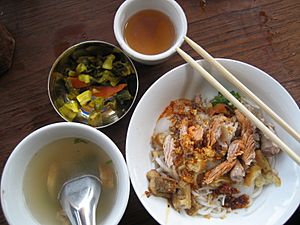
Noodle soups include:
- Mohinga (မုန့်ဟင်းခါး [mo̰ʊɴhíɰ̃ɡá]) – The unofficial national dish, made with thin rice noodles in a fish broth with onions, garlic, ginger, and banana stem cores. Served with boiled eggs and fried fishcake.
- Ohn-no khauk swè (အုန်းနို့ခေါက်ဆွဲ [ʔóʊɴno̰ kʰaʊʔsʰwɛ́]) – Curried chicken and wheat noodles in a coconut milk broth, similar to Malaysian laksa or Northern Thai khao soi.
- Kyay oh (ကြေးအိုး [tʃé ʔó]) – Rice noodles in a pork broth with egg, traditionally served in a copper pot.
- Kawyei khao swè (ကော်ရည်ခေါက်ဆွဲ [kɔ̀ jè kʰaʊʔ sʰwɛ́]) – Noodles and duck or pork curry with five-spice powder in broth with eggs, similar to Singaporean/Malaysian lor mee.
- Mi swan (မြူစွမ် [mjù swàɴ]) – Thin wheat noodles, often eaten by sick people with chicken broth.
- Shan khauk swé (ရှမ်းခေါက်ဆွဲ [ʃáɴ kʰaʊʔsʰwɛ́]) – Rice noodles with chicken or minced pork, vegetables, and crushed peanuts, served with tofu fritters and pickled mustard greens.
Burmese Salads
Burmese salads (Burmese: အသုပ်; athoke) are a wide range of unique salads. They are made from cooked and raw ingredients mixed by hand to create a balance of flavors and textures. Burmese salads can be eaten as snacks, as side dishes with curries, or as main meals.
- Lahpet thoke (လက်ဖက်သုပ် [ləpʰɛʔ ðoʊʔ]) – A salad of pickled tea leaves with fried peas, peanuts, garlic, sesame, tomato, chili, dried shrimps, and ginger, dressed with peanut oil, fish sauce, and lime.
- Gyin thoke (ချင်းသုပ် [dʒɪ́ɰ̃ ðoʊʔ]) – A salad of pickled ginger with sesame seeds.
- Khauk swè thoke (ခေါက်ဆွဲသုပ် [kʰaʊʔsʰwɛ́ ðoʊʔ]) – Wheat noodle salad with dried shrimps, shredded cabbage and carrots, dressed with fried peanut oil, fish sauce, and lime.
- Let thoke son (လက်သုပ်စုံ [lɛʔ θoʊʔzòʊɴ]) – Similar to htamin thoke but with shredded green papaya, carrot, sea moss, and often wheat noodles.
- Nan gyi thoke (နန်းကြီးသုပ် [náɰ̃dʒí ðoʊʔ]) – A thick rice noodle salad with chickpea flour, chicken, fish cake, onions, and other toppings, dressed with oil, fish sauce, and lime.
- Samusa thoke (စမူဆာသုပ် [səmùsʰà ðoʊʔ]) – Samosa salad with onions, cabbage, fresh mint, potato curry, and spices.
- Kya zan thoke – Glass vermicelli salad with boiled prawn, mashed curried duck eggs, and potatoes.
Burmese Curries
Burmese curry refers to many dishes where meat or vegetables are cooked in a base of flavorful spices. Burmese curries are usually different from other Southeast Asian curries (like Thai curries) because they use dried spices in addition to fresh herbs, and they are often milder. The most common type of curry is called sibyan (ဆီပြန်; meaning "oil returns"), which means a layer of oil separates from the gravy after cooking. Pork, chicken, goat, shrimp, and fish are commonly used in Burmese curries.
- Pork sibyan (ဝက်သားဆီပြန်) – A classic Burmese curry with fatty cuts of pork.
- Chicken sibyan (ကြက်သားဆီပြန်) – The classic Burmese chicken curry, served with a thick gravy.
- Bachelor's chicken curry (ကြက်ကာလသားချက်) – A red, watery chicken curry cooked with calabash.
- Goat hnat (ဆိတ်သားနှပ်) – A braised goat curry spiced with masala, cinnamon, bay leaf, and cloves.
- Nga thalaut paung (ငါးသလောက်ပေါင်း [ŋəθəlaʊʔbáʊɴ]) – A curry of hilsa fish and tomatoes, cooked slowly until the fish bones melt.
- Egg curry (ဘဲဥချဥ်ရည်ဟင်း) – A sour curry made with hardboiled duck or chicken eggs, cooked in tamarind paste and mashed tomatoes.
Soups
In Burmese cuisine, soups usually come with meals that have rice and noodles. They are chosen to balance the flavors of the main dishes. Lightly flavored soups, called hin gyo (ဟင်းချို), are served with saltier dishes. Sour soups, called chinyay hin (ချဉ်ရည်ဟင်း), are paired with rich, fatty curries.
Thizon chinyay (သီးစုံချဉ်ရည် [θízòʊɴ tʃìɴjè], meaning "sour soup of assorted vegetables"), cooked with drumstick, lady's finger, eggplant, green beans, potato, onions, ginger, dried chili, boiled eggs, dried salted fish, fish paste, and tamarind, is a special version of chinyay hin served during celebrations.
Other Grains and Breads
Indian breads are often eaten for breakfast or tea in Myanmar. Palata (ပလာတာ), also known as htattaya, is a flaky fried flatbread similar to Indian paratha. It's often eaten with curried meats or as a sweet dessert with sugar. Nanbya (နံပြား), a baked flatbread, is eaten with Indian dishes. Other popular choices include aloo poori (အာလူးပူရီ), chapati (ချပါတီ), and appam (အာပုံ).

Other dishes include:
- Burmese tofu (ရှမ်းတို့ဟူး [ʃáɴ tòhú]) – A type of tofu from Shan State, made from chickpea flour. It's eaten as fritters, in salads, or as porridge.
- A sein kyaw (အစိမ်းကြော် [ʔəséɪɴdʒɔ̀]) – A stir-fry with cabbage, cauliflower, carrot, green beans, baby corn, tomatoes, and squid sauce.
- Ngapi daung (ငါးပိထောင်း) – A spicy Rakhine-style sauce made from pounded ngapi and green chili.
- Nga baung htoke (ငါးပေါင်းထုပ် [ŋəbáʊɴ doʊʔ]) – A Mon-style steamed parcel of mixed vegetables and prawns, wrapped in leaves.
- Wet tha chin (ဝက်သားချဉ် [wɛʔ θə dʑɪ̀ɴ]) – Shan-style preserved minced pork with rice.
Snacks
Burmese cuisine has many traditional snacks called mont. These can be sweet desserts or savory foods that are steamed, baked, fried, deep-fried, or boiled. Traditional Burmese fritters, made from battered and deep-fried vegetables or seafood, are also eaten as snacks or as toppings.
Savory snacks include:
- Hpet htok (lit. leaf wrap, ဖက်ထုပ် [pʰɛʔtʰoʊʔ]) – Meat wrapped in pastry, with ginger, garlic, pepper, and salt. Usually served with soup or noodles.
- Samusa (စမူဆာ [səmùzà]) – Burmese-style samosa with mutton and onions, served with fresh mint, green chili, onions, and lime.
- Burmese pork offal skewers (ဝက်သား တုတ်ထိုး [wɛʔθá doʊʔtʰó]) – Pork offal cooked in light soy sauce, eaten with raw ginger and chili sauce.
- Htamane (ထမနဲ [tʰəmənɛ́]) – A dessert made from glutinous rice, shredded coconuts, and peanuts.
Sweet snacks include:
- Mont let hsaung (မုန့်လက်ဆောင်း [mo̰ʊɴlɛʔsʰáʊɴ]) – Tapioca or rice noodles, glutinous rice, grated coconut, and toasted sesame with jaggery syrup in coconut milk.
- Sanwin makin (ဆနွင်းမကင်း [sʰà.nwɪ́ɴ məgɪ́ɴ]) – A semolina cake with raisins, walnuts, and poppy seeds.
- Shwe yin aye (ရွှေရင်အေး [ʃwè jɪ̀ɴ ʔé]) – Agar jelly, tapioca, and sago in coconut milk.
- Pathein halawa (ပုသိမ်ဟလဝါ [pəθèɪɴ ha̰ləwà]) – A sticky sweet treat made of glutinous rice, butter, and coconut milk, inspired by Indian halwa.
- Hpaluda (ဖာလူဒါ [pʰàlùdà]) – Rose water, milk, coconut jelly, and coconut shavings, sometimes served with egg custard and ice cream, similar to Indian falooda.
- Ngapyaw baung (ငှက်ပျောပေါင်း) – A Mon-style dessert of bananas stewed in milk and coconut, topped with black sesame.
- Saw hlaing mont (စောလှိုင်မုန့်) – A Rakhine-style baked sweet, made from millet, raisins, coconut, and butter.
Fruits and Fruit Preserves
Myanmar has many different fruits, mostly tropical ones. Fruit is commonly eaten as a snack or dessert. While most fruits are eaten fresh, some, like jengkol, are boiled or roasted. Popular fruits include banana, mango, watermelon, papaya, jujube, avocado, pomelo, and guava. Others include marian plum, mangosteen, sugar-apple, rambutan, durian, jackfruit, lychee, and pomegranate. Burmese fruit preserves, called yo (ယို), are also commonly eaten as snacks. Common ones are made from fig, jujube, marian plum, citrus, mango, pineapple, and durian.
Beverages
Tea is the national drink of Myanmar. This shows the influence of Buddhism and its ideas about being moderate. Tea is very important in Burmese dining; free green tea is usually served to customers in restaurants and teashops. Drinks made from fruits and coconut milk, like sugarcane juice and mont let hsaung (မုန့်လက်ဆောင်း), are also popular. Local fermented drinks like palm wine are found across the country. During a traditional Burmese meal, drinks are not often served; instead, a light broth or soup is usually offered from a communal bowl.
Burmese Tea
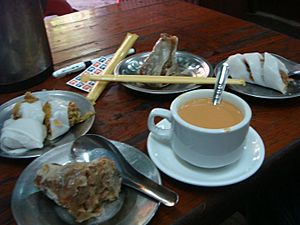
Plain green tea, yay nway gyan (ရေနွေးကြမ်း, meaning "crude tea water"), is a popular type of tea in Myanmar. Tea leaves are traditionally grown in Shan State and Kachin State. Milk tea, called laphet yay cho (လက်ဖက်ရည်ချို), is also popular. It's made with strong black tea leaves, sweetened with a mix of condensed milk and evaporated milk.
Places to Eat
Restaurants
Dine-in restaurants that serve steamed rice with traditional Burmese curries and dishes are called htamin saing (ထမင်းဆိုင်; meaning "rice shop").
Tea Shops
During the time the British were in charge of Burma, Burmese Indians brought tea shops to the country. These were first known as kaka hsaing, and later became laphet yay hsaing (လက်ဖက်ရည်ဆိုင်) or kaphi (ကဖီး), which comes from the French word "café." Burmese tea shop culture grew from a mix of British, Indian, and Chinese influences during that time. Tea shops are everywhere in Myanmar and are an important part of community life. They are usually open all day, and some serve locals, long-distance drivers, and travelers. People gather in tea shops to drink milk tea and eat many different snacks and meals.
Street Food
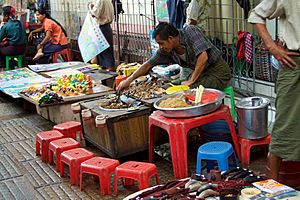
Street food stalls and hawkers are a common sight in Burmese cities, especially in big ones like Yangon. Burmese salads, snacks, and fritters are very popular street foods. In recent years, some big cities have started to organize street food vendors. For example, in 2016, Yangon moved its street vendors to special night markets.
Night markets, called nya zay (ညဈေး), are found in many Burmese towns and cities. People noticed Burmese street hawkers selling tasty foods like fruits, cakes, and laphet at "night bazaars" as early as 1878. The streets around big daytime markets often turn into night markets in the evenings.
|
See also
 In Spanish: Gastronomía de Birmania para niños
In Spanish: Gastronomía de Birmania para niños


